|
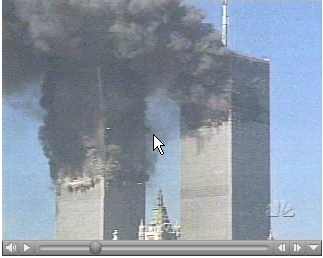
The pattern shown is evidenced throughout the collapse on many different videos with many of these flashes
and emissions being seen at the same position relative to the corners of the perimeter structure, and at planes the same
general distance apart.
These phenomena occur in a consistent geometric pattern as they appear immediately before and during the collapse, and
when regarded in the context of the tower construction the pattern is relevant.
Professor Jones has highlighted and examined the molten metal which was seen issuing from the side of the towers immediately
before collapse initiation. This was also at the same relative position to the corner.
| Molten metal stream |
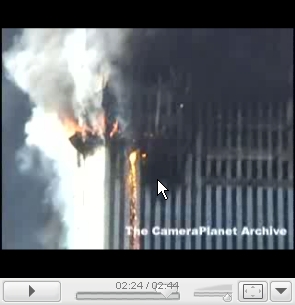
|
The corner column areas were by their nature one of the most rigid section of the towers and were to a large
extent exempt from the loading applied by the core through the floors.
Removing the ability of these columns leaves only the mid wall sections to carry all of the load above Plane
2 and all of the core load above Plane 1. The load would act both downwards and inwards through the floors on these remaining
columns, and at that point, collapse of the area between these planes began. This was the disintegration of the upper section
that commentators have noted. In actuality a partial disintegration.
The planes were located as follows; Plane 3 at or about the storey where the bend in the upper section occurred
and Plane 2 at or about the storey from where the molten metal was seen to be expelled. These represent the upper and lower
bounds of the volume which was first crushed.
The following graphics obtained from the excellent terrorize.dk site show this very clearly. These photographs
in and of themselves destroy the arguments of Dr. Bazant and his fellow advocates of the "crush-down crush-up" theory of collapse. They
demonstrate that the first storeys to undergo crushing were those between the two planes indicated. The lower collapse
front did not accelerate at the same rate as the roof line.
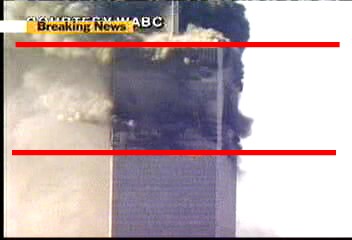
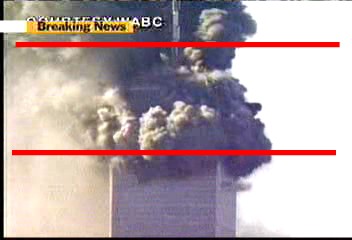
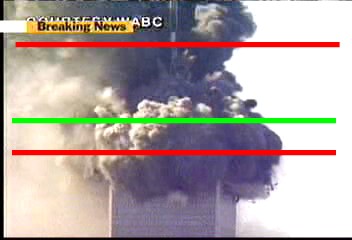
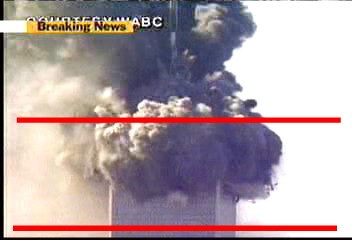
| Bend develops at site of smoke emission |
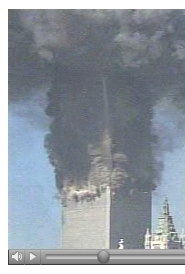
|
It is exactly at these planes that the first obvious failures are seen to occur.
The corner of WTC2 is seen to bend at the point where the smoke emanates in the photograph above and
at the lower plane indicated by the second photograph.
Examination of video evidence shows that the following phenomenon coexist in time and space.
1/ distinct colour changes in smoke
2/ behavioural changes in the smoke emissions
3/ flashes of light
4/ local and definable damage.
| lower plane seat of failure |
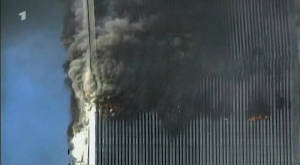
|

| upper plane seat of failure |
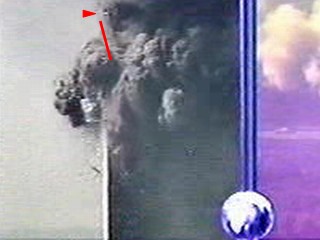
|
Note also the distinct white flash identified on previous photographs and still existing on
the photograph above, now at a later stage of the collapse and now moving with the falling upper section.
Rotation of upper section.
The upper section of WTC2 appears upon first examination to tilt as one piece about a fulcrum located at the
aircraft impact level. Closer examination reveals that there is a distinct bend in the line of the corner columns and the
top storeys of the upper section, those which are above the bend do tilt, but in the section below, more obscured by smoke,
there is less, or even no, rotational movement in the line of columns. The upper section did not necessarily display the behaviour
expected by some commentators and in particular it has been said that the conservation of angular momentum was not observed.
Because the core failure occurred at a lower level than aircraft
impact the core structure projecting below the impact level would give a "keel" action to the upper section as it fell.
It would also give a different fulcrum position for the rotation, than has been previously examined. This may account
for some questions which have been asked.
This can be envisaged by imagining a Christmas tree being pulled downwards through a packaging funnel.
The force only has to be generally downwards to have the trunk passing through the centre and it will tend to straighten
or arrest any tilt of the tree.

Note that the collapse front, plane 2 does not begin to move downwards immediately, there is a distinct time
difference between the first movement of the upper section and the first movement of the collapse front.
The collapse front also exhibits strange behaviour which has not been addressed by the official inquiries.
Phase 3
The object of Phase three was to progress the collapse by severing the columns which made up the perimeter
of the core structure and disassociating them from the remainder of the core structure.
Effects of Phase Three
The upper core structure and floors being pulled down inside the lower structure would meet resistance from the floors
below. To facilitate the collapse the 24 columns which made up the perimeter of the core and to which the floors
were connected, were severed and broken free of the bracing which held them connected to each other and to the remainder of
the core.
Evidence of phase three
Collapse of outer core columns
Credit for the following new piece of information, as of
April 07, must go to Muhammad Columbo. His perseverance and abilities have added another facet to this analysis
and delivered a knockout blow to the official analysis of events.
The photograph by Aman Zafar previously shown and commented upon, appears
to show the lower core structure still upright after the floors and perimeter columns had collapsed to ground level.
However, this is not the full story. Muhammad's analysis shows that the remaining core was too narrow to be the entire
core, and was in fact, the inner 23 core columns. The 24 core columns which made up the outer perimeter of the
core structure and to which the floors were connected are clearly absent from the photograph. Thus we can see that the
outer core columns fell in the early stages of the collapse along with the floors and perimeter walls. For this to happen,
the bracing which attaches these outer core columns, both to each other and to the inner core columns would have to be
severed and each column broken into sections.
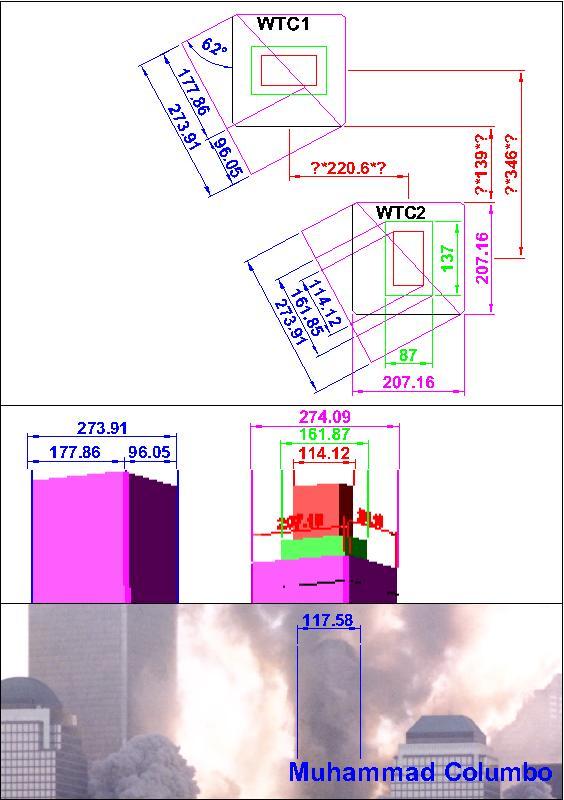
Behaviour of ejections
Almost immediately after collapse initiation there followed a rapid series of expulsions of dust and
debris issuing simultaneously from horizontal lines across all walls of the tower simultaneously. These progressed rapidly
downwards and in some instances their progression was faster than that of objects falling outside the tower.
The photograph above shows the first early stages of these expulsions on the same level as the highlighted
flash.
It has been argued that the expulsions in the early stages of collapse were caused by air pressure between
pancaking floors but the tilting of the upper section would not allow the symmetry in the collision between floors required
for the symmetry of the expulsions.
Simultaneous emissions of trapped air across whole floors could only be caused by straight down
collapse of one floor onto another and thus the tilting of the upper section rules this out as a cause for the behaviour of
the expulsions. In other words the tilting rules out pancacking floors as an explanation for the
ejections of dust and debris.
Further refutation of theories which explain these expulsions as being part of a
gravity only collapse is found by examination and identification of the storeys from which these expulsions are
emitted. The following analysis shows that the expulsions do not occur on every storey but rather from
storeys about four or five apart with no such comparable expulsions from storeys between.

These first two photographs show the progression of the expulsions down from the collapse
front. These photographs were taken from the 911research site where the timing is given as 30 frames per second, and
the photographs are numbered based on this timing. This gives a time difference of just under a quarter of a second.

The difference to note in these photographs is that the expulsions in 195 are from about four storeys
above those in 203. No expulsions are evident from the intervening floors.
Use the spire as a reference to see this effect more clearly or visit the 911research site, to see a full
array of photographs.

Note in photograph 243 that the corner section is not affected by the expulsions. They remain visible
for a period as the dust cloud expands around them from other sources. This is common to all of the videos witnessed.
The corners of the perimeter sections are not involved with the expulsions of dust in the early stages of collapse.
A gravity driven collapse involving each storey in turn would have similar phenomenon being visible from
each storey in turn. This was not observed and the phenomenon of the expulsions must therefore have as their
cause, something other than a gravity driven collapse involving each storey in turn.
Behaviour and failure of perimeter corner sections
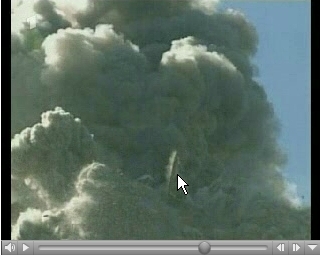
|
| Corner below initiation level remains upright |
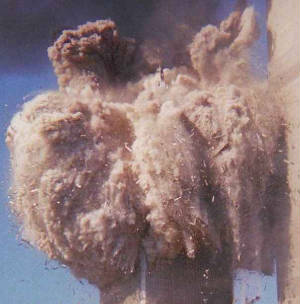
|
| Corner section exposed through falling debris |
Note also that the corner columns below plane 2, unlike the mid wall columns, do not collapse with the collapse
front, but remain standing for a period of time, before then falling inwards.
These corners do fail at a slightly later stage and in at least some cases fall inwards after collapse has
progressed below their level again showing the spacing and pattern of the planes under attack. It would not be necessary
to continue these attacks all the way to ground level.
The survival of these corner sections of the perimeter structure, show the order of collapse. To
allow this two vertical lines of spandrel plates - the perimeter horizontal bracing - have to be disassociated at each
corner. The mid wall columns disassociated from the floors, can fall outwards, while the corners remain upright.
The later failure of these corner sections, and particularly the arcs which they describe as the fall, showing
that further failures took place above ground level, are evidence of further attacks on the corners as in Phase two,
at other planes below the impact levels. This is again reinforced by flashes of light and smoke emissions.
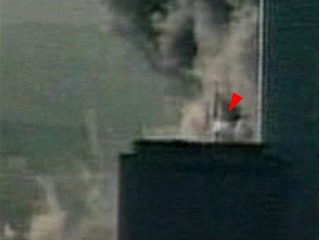
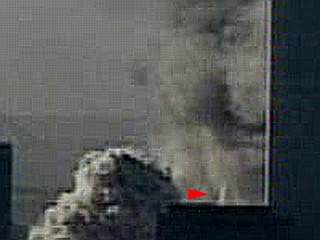
These two photographs, again from terrorize.dk, graphically show the eventual failure of one such
corner section. The failure is again seated at the point in time and place of the flash of light.
Expulsions from lower floors
As mentioned previously, in the area of the maintenance floors there was a more robust structure to satisfy
local load considerations. These required special attention from the demolition. The following photographs showing
large expulsions from those areas before the collapse front approaches their position shows the independence of these effects
from the collapse front.
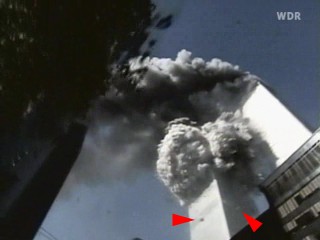
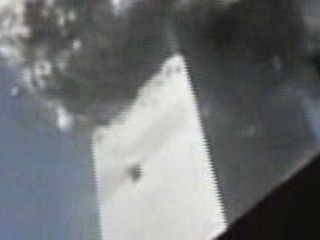

| Flashes below initiation level |
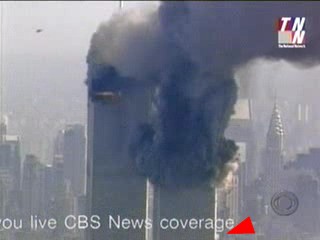
|
In short the progress of the collapse below the aircraft impact level was facilitated by detaching the
floor to column connections below this level, and by attacking the spandrel plates connecting the corner perimeter columns
to the mid wall perimeter columns. This is accompanied both in time and place by the expulsions of dust/debris. The mid wall
perimeter columns below the aircraft impact, fall outwards as the upper section is pulled down inside them by the falling
core.
Phase 4
The object of Phase Four was to complete the collapse by attacking the remaining core structure both horizontally
at lower levels and vertically by disassociating the horizontal bracing.
Effects of Phase Four
The disassociation of the horizontal bracing and the division of the core columns into short lengths allows the core structure
to progressively break apart and collapse over a time period of a few seconds.
Evidence of Phase Four
Flashes of light throughout lower core section
The first six or so seconds of the above video shows many short duration, flashes of light, intense enough to be
seen through the clouds of dust and smoke. Note that I have tried but am unable to take screen captures from
this video to illustrate these flashes. If anyone can supply these I would be very grateful.
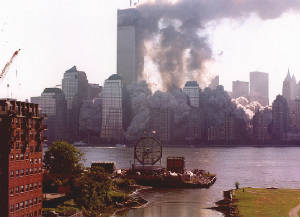
This second photograph by Aman Zafar shows the collapse of the remaining section
of the core. Taken only a few seconds later the top of the core structure is only just visible.
Most notable and revealing aspect of the survival of the core until this late stage
of the collapse lies in how they behaved when they did fall. The columns fell independently of each other
showing that all of the horizontal bracing which previously connected them had been severed.
| Collapse of remaining core |
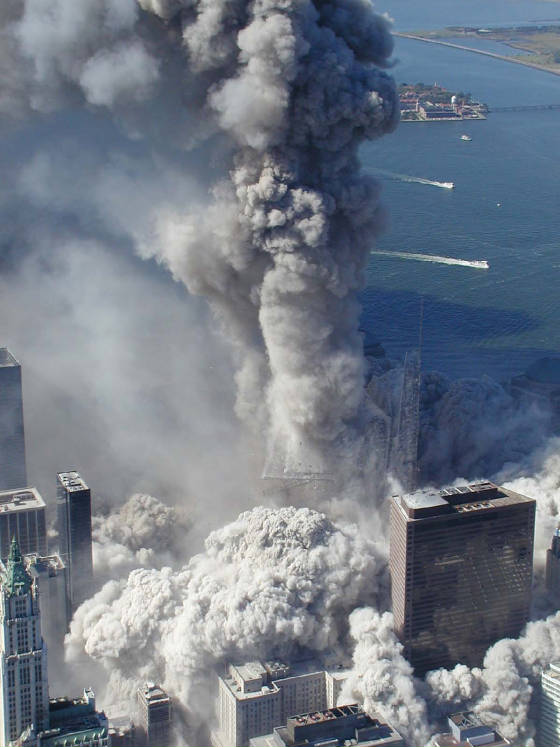
|
| closer detail of core collapse |
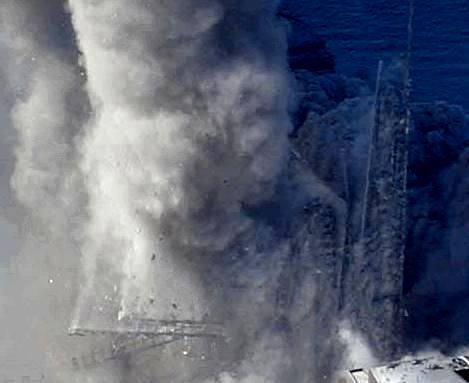
|
Disassociation of the core structure
Look at the arc described by the falling core sections in this photograph. The centre of rotation is
not at ground level which shows that failures have taken place at a level which is above ground level. Note also
that the core columns are falling independently of each other and this has been made possible by the disassociation of the
horizontal bracing. This is not a mechanism which can be plausibly explained by a gravity only collapse, since this
would require that, as a result of predominately vertical forces during the collapse of the floors and perimeter structure,
all of the horizontal bracing was completely severed, yet the columns remained upright. Then the columns themselves
in turn failed into straight sections showing no other sign of attack.
Appearance of the ends of failed columns
The ends of these relatively straight column sections have a luminous appearance and they emit and
trail smoke as they fall. This is a sign of thermal activity and this appearance would not be caused by a purely
mechanical failure.
No gravity only collapse could cause such precise disassociation of the core structure
into constituent pieces, nor could it be responsible for the smoke and flashes of light.
| Column end from debris pile |
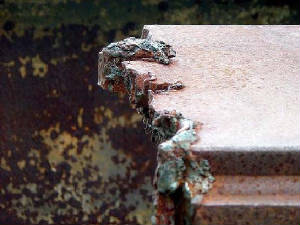
|
Note the highly unusual appearance of the end of this column. This is not what we would expect
from a column which had been fractured by a mechanical force alone.
The material adhering to the columns would have been fully investigated and identified by a competent investigation.
In such an investigation the column should have been identified as to its original position in the tower structure and examined
on a microscopic level to ascertain the extent of any Heat Affected Zone and this would tell us, the nature and extent of
any thermal effects which may have accounted for this appearance.
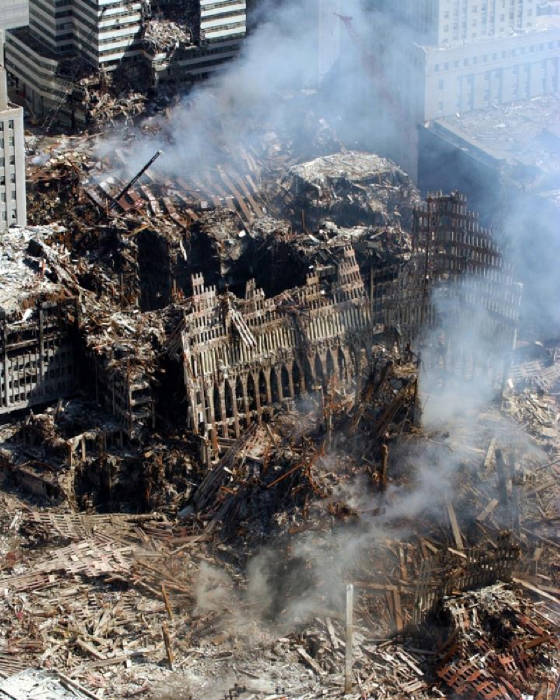
Conclusion
This analysis shows the order of the collapse from initiation to completion of the collapse. It has
identified the outline procedure which was used to cause the towers to fall. A consciencious investigation would have
revealed all of these pieces of evidence and explained what each piece meant in terms of the initiation and progression of
the collapse.
The 911 Commission, FEMA, and NIST examined the collapse and were charged with explaining the mechanisms of
the collapse. Not only did they fail to adequately do so, they failed even to identify and incorporate the various pieces
of evidence detailed in this analysis.
This page is under construction and further details will be added as work on the final version progresses. These
details will include the evidence upon which my deductions have been made.
|

